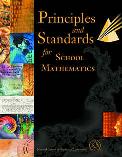|
|
|
|
|
| National Science Education (NSE) Standards
|
top
Please note that The
NSE Standards is a very thorough document and is difficult to
navigate since it was written for a variety of audiences and it
not obvious from the table of contents exactly which sections are
intended for teachers' use in the classroom. To save time when
referencing the standards, you may want to skip directly to the
information pertaining to the Content Standards for grades 5-8,
which begins on page 143.
-
Content Standard A: Science as Inquiry
This standard is absolutely central to the solar rotation
investigation. Goal 1 is to help students develop several
fundamental abilities that support the ability to perform
Science as Inquiry as they:
- Design and conduct a scientific investigation,
- Use appropriate tools and techniques to gather, analyze,
and interpret data,
- Think critically and logically to make the relationships
between evidence and explanations,
- Communicate scientific procedures and explanations, and
- Use Mathematics in all aspects of scientific inquiry.
For more detail on any of these points, see Content Standard
A in the NSE
Standards .
-
Content Standard D: Earth and Space Science
Although the Sun is the object of study for this activity,
the inquiry does not directly address the Earth and Space
Science Standard. However, students will be exposed to a
surprising example of the kind of regular, periodic motion that
is ubiquitous among celestial bodies. Thus, the activity can
serve as both a segue and an illustration for a discussion of
the periodic motions in the solar system that are central to the
Earth and Space Science Standard. Such a discussion might begin
with the question, "Does it strike anyone as odd that everything
in space seems to be rotating about an axis and/or orbiting
about something else?"
-
Content Standard G: History and Nature of Science
A fundamental tenet of this standard is the understanding of
The Nature of Science , which is efficiently conveyed by
the fact that the data the students have at their disposal (not
to mention the strategies they will develop to interpret the
data) are basically the same as that used by the scientists who
determined the solar rotational period to begin with (Galileo
was the first). So as the students work through the activity,
they are actually recreating a part of scientific history!
Goal 2 is that students will gain improved perspective on
the Nature of Science. To this end, students will see
first-hand a key aspect of the Nature of Science.
It is part of scientific inquiry to evaluate the results of
scientific investigations, experiments, observations,
theoretical models, and the explanations proposed by other
scientists. Evaluation includes reviewing the experimental
procedures, examining the evidence, identifying faulty
reasoning, ...
--NSE Standards,
1996
|
| National Council of
Teachers of Mathematics (NCTM) Standards |
top
While The NCTM
Standards is as thorough a document as the NSE Standards, it
was written primarily for teachers, and you will have no trouble
navigating by its transparent table of contents.
-
Number and Operation
A key to this standard is the understanding of the
meanings of operations and how they relate to one another.
At some point in this activity, most students will have to
confront a situation such as this: If a spot moves 3/4 of an
inch in a day, and must traverse 20 inches for the sun to
complete a rotation, how long will one rotation take? The
student will have to think carefully about the meaning of
arithmetic operations to realize that the required number of
days is just the number of times 3/4 goes into 20, or 20
divided by 3/4.
-
Geometry
Geometry Standard principles lie at the core of the solar
rotation investigation. Goal 3 is to improve students'
command of practical geometry skills. As urged by the NCTM,
students will:
- Analyze Characteristics and properties of two- and
three-dimensional geometric shapes and develop mathematical
arguments about geometric relationships;
- Use visualization, spatial reasoning, and geometric
reasoning to solve problems.
-
Problem Solving
In this standard, the NCTM calls on instructional programs to
(among other things) "enable students to apply and adapt a
variety of appropriate strategies to solve problems." Students
will expand this skill as they develop their methods and discuss
these methods and others with the rest of the class.
-
Connections
Here, a basic skill for students is to be able to "recognize
and apply mathematics in contexts outside of mathematics," which
is central to this
project.
| |
 Relevance
Relevance
 Relevance
Relevance